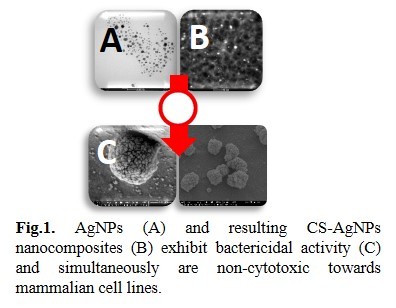| Search for content and authors |
Biocompatible and bactericidal chitosan-silver nanocomposites |
| Anna Regiel-Futyra 1, Małgaorzata Kus-Liśkiewicz 2, Manuel Arruebo 3,4, Grażyna Stochel 1, Agnieszka Kyzioł 1 |
|
1. Jagiellonian University, Faculty of Chemistry, Ingardena 3, Kraków 30-060, Poland |
| Abstract |
The increasing number of Multidrug-Resistant (MRD) bacterial strains makes a need of searching innovative biomaterials exhibiting antibacterial activity very urgent1. Several desirable properties such as biocompatibility, biodegradability and non-toxicity against human cells are required. Among a number of current strategies, the synthesis of metal nanoparticles as fillers inside polymers and further bionanocomposite preparation methods draw a lot of attention2. Present studies concern chitosan (CS) based silver nanoparticles (AgNPs) and further composites as solid films. Different variables have been analyzed in order to optimize the bactericidal properties of silver nanoparticles embedded in chitosan films. The main challenge was to achieve a complete bactericidal effect against antibiotic-resistant, biofilm forming Gram-negative (Pseudomonas aeruginosa, Eschierichia coli) and Gram-positive (Staphylococcus aureus) bacterial strains with simultaneous low (or even lack) cytotoxicity towards mammalian cell lines. 
The best results were obtained for materials based on chitosan with the medium molecular weight and the highest deacetylation degree where a fast reduction of silver ions was favored. It leads to smaller nanoparticle formation and a homogenous NPs dispersion across the membrane)3. Bactericidal effect towards Gram-negative and Gram-positive bacterial strains (Fig.1) and low cytotoxic effect towards human keratinocytes were obtained in vitro. This results make the obtained nanocomposites perfect candidates for many biomedical application including wound dressings, antimicrobial coatings on medical devices and so on.
Acknowledgements: This work was supported by the National Science Centre through the PRELUDIUM (2012/07/N/ST5/00157) project.
[1] WHO. http://www.who.int/mediacentre/factsheets/fs194/en/ 2014. |
| Legal notice |
|
| Related papers |
Presentation: Poster at Nano PL 2014, Symposium B, by Anna Regiel-FutyraSee On-line Journal of Nano PL 2014 Submitted: 2014-09-10 09:40 Revised: 2014-09-10 09:43 |